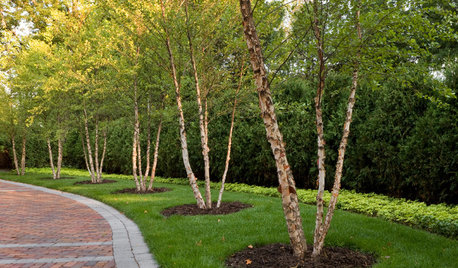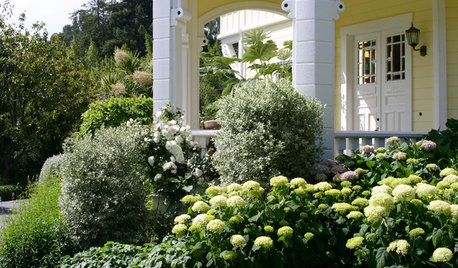Pine Bark Fines and Soil ph or Acidity
bmoke
15 years ago
Featured Answer
Sort by:Oldest
Comments (22)
johnsvmf
15 years agolast modified: 9 years agocastlemaster
15 years agolast modified: 9 years agoRelated Discussions
Pine Bark Fines VS. Aspen Bark
Comments (14)I believe Al's recipe is 3-5 parts bark fines, 1 part turface or perlite and 1 part peat (would have to go look to be certain). What I am using this year is 2 parts bark fines, 1 part turface or perlite and 1 part peat. I do like this mix (certainly more than the mostly peat mixes from the store) and it retains water quite well (drying too quickly was my main concern since I grow a lot of water hungry plants), but overall I think the next time I make a mix I will reduce the peat as I can already see how the peat is mucking up the drainage. The bark fines actually hold a lot more water than I thought they would and the Turface is also quite good at retaining water. The peat is as well, of course, but it breaks down to muck inside one season whereas the Turface (or perlite) never will and the bark will take a couple/few years to do so. I do like the current ratio in self watering containers though. Probably would keep the mix the same with those....See MoreAged Pine bark Fines as soil ammendment...
Comments (21)Trust me on this, Kimmsr gives really good, true advice. I already used pine bark to help my clay soil, sure it really works to make a faster draining soil. The fact is- mulching with compost which feeds the micro life in the soil; makes a loose soil. We may be looking at the bark as a quik fix, when building the soil using compost will creats a long tearm rich, yet loose soil. The more activity of soil organisms will make an easy to grow in soil. I used to install plants and of course we did not have time to build the soil of the location the plants were being planted. The specific landscaper I worked with liked using sand/peat to mix with the soil to loosen it up- a big no no if you ask me as sand just made it heavy and was too fine. I suggested we used mushroom compost that we could get by the truck load for cheap, it worked really great. The landscaper showed me some pruning techniques, and I helped them understand they never have to haul sand ever again!! So, really in the long run- you could add compost/leaves/ect to any native soil type and it will improve over time to the "perfect soil"....See MoreWhich Farfard soil mix as a proxy to Pine Bark Fines?
Comments (1)Actually the Farfard #52 is considered a reasonable replacement for the gritty mix, not an additive. I would feel comfortable using it in its entirety for a potted JM - I use a prepackaged soil mix very similar to that myself for all my JM's.The other Farfard mixes that are usually available in retail outlets don't quite measure up in terms of quality and durability. Can you ask your source to special order the #52 for you? If unable to take this shortcut with the Farfards #52 and continue on with your homemade gritty mix, I'd persist in my quest for bark fines. Using another soil mix is just not an appropriate substitute. Bark fines can often be found under the label of "soil conditioners" - and they do not have to be pine. You can also often find them sold in pet stores as reptile bedding ( at a pretty inflated price, btw)....See MoreNewbie to SFG - Question about Fine Pine Bark
Comments (20)Thank you to everyone in answering my questions. Since our planting season here in Florida begins February 15th for Spring planting I have to make some decisions on my soil mixture now. I read though about 30 pages of old SFG forum threads going back to 2005. I also have some thoughts after reading many of the postings. This is only my opinion based on past experiences with soiless mixtures and from what I gleamed from the postings. I believe that to have very good to excellent success with Mel's mixtures, whether you use his old formula or the new, you need to be using your own ripe compost. Nothing in a bag is going to match the richness of home-grown compost. I believe that is why some of the new people to the SFG method have lukewarm results. Here in Florida, to grow roses, our local rose society chapter recommended excavating a hole 18"x18" and filling it with a soiless mixture very much like Mel's original soil recipe. We used several organic amendments including the fine pine bark mixed with peat and compost. So, my plan is to mix my rose soil recipe for my new 4x4 foot bed and do a PH test on the finish mixture. I will have no homegrown compost in this bed, but I plan to grow mostly herbs this first season. My second bed is 4x8 and 10 1/2" deep. For this bed, I am going to use Mel's new soil proportions and use a bag of soil conditioner pine bark along with bagged manures and my own leaf compost which is a year old and totally broken down. I plan to also incorporate greensand, soft rock phosphate & gypsum, all of which I already have on hand. Again I will do a ph test on the finish bed. This bed is going to be mostly beans,limas and green pole beans and one yellow squash. We have another growning season in the Fall for lettuce, spinach and many of the other veggies you'll grow in the Spring. My third bed, another 4x8 bed, will become a compost bed for the spring and summer. Our leaf gathering and raking is just now beginning here. I will hope to get a nice load of horse manure and mushroom compost to add to the oak leaves. I will also build my three compost bins for my side dressing next year. I plan to keep a journal of the results of these soil mixtures for future beds and will gladly past along the results. I will enjoy reading your postings as the growing year nears for all of you on this forum. I have learned more from reading thru the past threads than I did attending 4 hours of classroom time for organic vegetable gardening. Thank you everyone! Mary...See Morebmoke
15 years agolast modified: 9 years agotapla (mid-Michigan, USDA z5b-6a)
15 years agolast modified: 9 years agoleon_edmond
15 years agolast modified: 9 years agobjs496
15 years agolast modified: 9 years agobmoke
15 years agolast modified: 9 years agotapla (mid-Michigan, USDA z5b-6a)
15 years agolast modified: 9 years agoleon_edmond
15 years agolast modified: 9 years agokeith-figs
15 years agolast modified: 9 years agobmoke
15 years agolast modified: 9 years agobmoke
15 years agolast modified: 9 years agokeith-figs
15 years agolast modified: 9 years agolathyrus_odoratus
14 years agolast modified: 9 years agoprestons_garden
13 years agolast modified: 9 years agolatekid
13 years agolast modified: 9 years agotapla (mid-Michigan, USDA z5b-6a)
13 years agolast modified: 9 years agonoss
13 years agolast modified: 9 years agotapla (mid-Michigan, USDA z5b-6a)
13 years agolast modified: 9 years agoMary Lalremzo
3 years agotapla (mid-Michigan, USDA z5b-6a)
3 years ago
Related Stories

GARDENING GUIDESHave Acidic Soil in Your Yard? Learn to Love Gardening Anyway
Look to acid-loving plants, like conifers and rhododendrons, to help your low-pH garden thrive
Full Story
GARDENING GUIDESGrow a Beautiful Garden in Alkaline Soil
Got alkaline soil? Learn how to manage it and the many beautiful plants that will thrive in this ‘sweet’ soil
Full Story
GARDENING GUIDESGardening Solutions for Heavy Clay Soils
What’s a gardener to do with soil that’s easily compacted and has poor drainage? Find out here
Full Story
GARDENING GUIDESHow to Pick a Mulch — and Why Your Soil Wants It
There's more to topdressing than shredded wood. Learn about mulch types, costs and design considerations here
Full Story
GARDENING GUIDESHow to Stop Worrying and Start Loving Clay Soil
Clay has many more benefits than you might imagine
Full Story
CONTAINER GARDENSContainer Gardening Basics: The Dirt on Soil
Learn the types of potting soil available and the best mixes to help your containers thrive
Full Story
LANDSCAPE DESIGNGreat Design Plant: River Birch
Pick this rugged native tree for its intriguing peeling bark, soil adaptability or leaves that bring dappled shade to a garden
Full Story
GARDENING AND LANDSCAPINGHave a Ball With Hydrangeas
Even if you don't tinker with the hue by changing the soil, hydrangeas have an entertaining range of uses in all kinds of landscapes
Full Story
FALL GARDENING5 Ways to Put Fall Leaves to Work in Your Garden
Improve your soil and yard the organic way with a valuable garden booster that grows on trees
Full Story
GARDENING GUIDESGarden Myths to Debunk as You Dig This Fall and Rest Over Winter
Termites hate wood mulch, don’t amend soil for trees, avoid gravel in planters — and more nuggets of garden wisdom
Full StorySponsored
Professional Remodelers in Franklin County Specializing Kitchen & Bath



lomodor